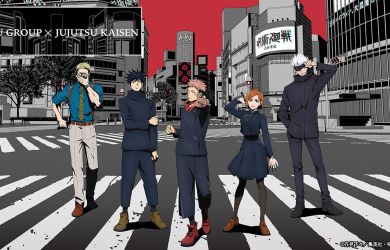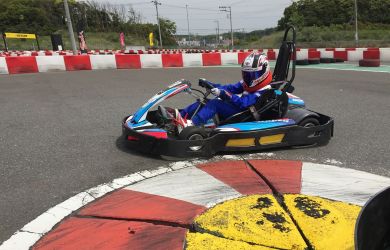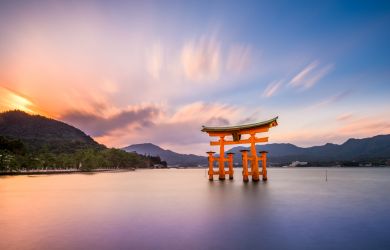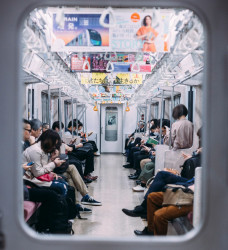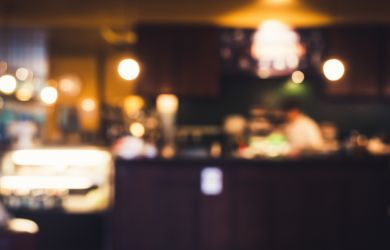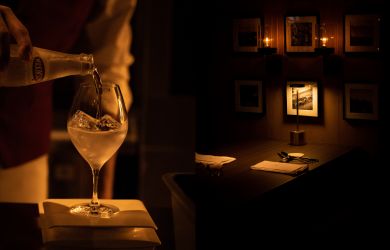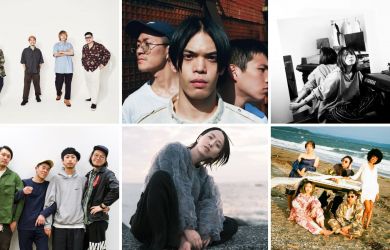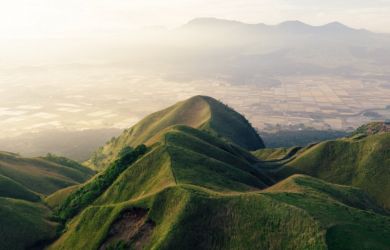
April 28, 2016
Experience Deep Koyasan
Finding soul space beyond the tourist track
My car slowly climbs across the seemingly countless slopes of the scenic Koya skyline. With every curve, anticipation grows to reach Koyasan, one of Japan’s most sacred places.
Located high up in a forested mountain valley and surrounded by eight peaks, this 1,200-year-old Buddhist mountain monastery attracts countless visitors year-round. Rather than just sightseeing, my intention this time is to find some quiet time to relax, practice mindfulness, and search for spiritual wisdom.
Many ways lead to Koyasan
The Koya skyline connects Kumano, another sacred area located in the south of the Kii Peninsula, with Koyasan in the north. In spring, the bright pink of the yama sakura (mountain cherry trees) and in autumn the flaming red and orange of momiji (maple leaves) capture one’s attention. This is a driver’s paradise. There are hardly any traffic lights for 70 kilometers, and every meandering turn reveals a gorgeous vista. There’s no better way for explorers-at-heart than to rent a car and drive.
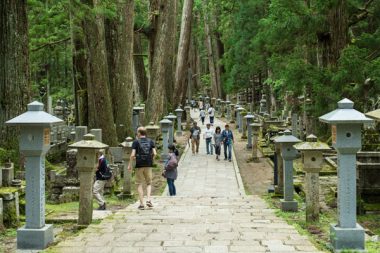
(Photo by Alena Eckelmann)
Kumano and Koyasan are also connected by a pilgrims’ trail, the Kumano Kodo’s Kohechi course, which crosses the steep mountains of the peninsula. Walking this trail might take four days, but by car one can reach Koyasan in just three hours from either Shirahama or Kii-Tanabe in the south.
The Kumano Kodo trails, which comprise the “Three Kumano Grand Shrines” located respectively in Hongu, Shingu and Nachi, and Koyasan, were inscribed as part of a UNESCO Heritage Site in 2004. But the history of these sacred Shinto and Buddhist sites in Wakayama Prefecture reaches back well over a thousand years.
The Buddhist monk Kobo Daishi is one of Japan’s most prominent saints and the founder of Japan’s Shingon branch of Esoteric Buddhism. Kobo Daishi opened up Koyasan in the 8th century as a place for monks to train, set in the remote mountains far away from worldly affairs. While Koyasan is less of a secret these days, escaping the hustle of city life is still its big draw.
The next stop on my trek through the world of Kobo Daishi—known as the “great teacher”—is to explore the various activities that monks engage in and trace the footprints of pilgrims to Koyasan’s sacred sites, Okunoin and Danjo Garan.
Lodging and eating like a monk
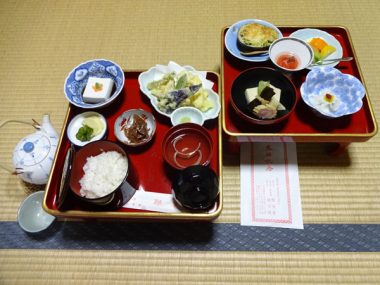
(Photo by Alena Eckelmann)
This time, I stay at Muryokoin Temple. There are 117 temples in Koyasan, and 52 of them accept guests for overnight stays. These shukubo, or temple lodgings, were originally meant for pilgrims but now also accept other visitors.
A monk greets me at the entrance, checks me in, and guides me to my room while explaining facilities and temple etiquette. He brings me a cup of tea and sweets just like you would receive at a traditional Japanese inn. Sitting on the tatami floor and sticking my legs under the kotatsu (heated blanket table) to keep warm, I slowly wind down and settle into Koya’s world.
My room is typically Japanese, with sliding doors, richly decorated with images of nature; white paper-screen windows; and an austere alcove that holds a vase and paper scroll. Dinner is served in the room while breakfast is taken in a larger hall together with other guests.
On the table I find wooden sticks, goma ki. These are prayer sticks that are put into the fire during the goma (traditional fire ceremony) in the morning. I learn that the sacred fire burns all hindrances to enlightenment. Anything that speeds up the process sounds good to me. I write my name, age, and wish on a couple of sticks and hand them over to the monks at the reception desk.
Around 6pm, a young monk politely announces himself outside the sliding door before entering. He brings in my dinner on two trays, which he sets out on the tatami floor. An ar-rangement of small bowls and dishes contains Koyasan’s famous shojin ryori, a vegan cuisine eaten by monks, consisting of tofu, beans, vegetables, and fruit. Famous are koya and goma tofu, the former being freeze-dried and the latter flavored with sesame. I learned that content and presentation are based on “five cooking methods, five flavors, and five colors.” Rice and a clear soup fill the remaining space in my stomach, and the meal is concluded with a cup of tea.
In search of “A”
I am sitting cross-legged in lotus position on a zabuton cushion folded in a triangle to support a straight posture. I sense the observational presence of a monk behind me as he provides instructions—“relax your body and follow your breath.” This practice is known as “ajikan,” a meditation used by Koyasan monks.
“A” is the first letter in the Sanskrit alphabet. It stands for beginning and birth. In Shingon Buddhism, “A” also refers to dainichi nyorai, the cosmic Buddha and the highest-ranking deity in the pantheon of Esoteric Buddhism in Japan. The ultimate aim of ajikan is to become one with this Buddha. Shingon teaches that Buddhist nature is in every one of us and we can awaken it and reach enlightenment in this very lifetime.
This sounds promising, although easier said than done. Sitting on my cushion, I concentrate on breathing in and out. On exhaling, I voice the letter “A” from deep in my belly into the space in front of me. It’s hard not to think about work piling up, family waiting for a visit, or the next holiday destination.
My one-hour meditation practice gives only a short glimpse into the world of the hard train-ing that Koya’s monks go through. Typically, they pass a three-year program before graduat-ing as fully-fledged monks. During this time, they serve as terasei (temple students). Their duties—not purely of a holy nature—include cleaning and serving guests like me, which is considered part of their induction.
Sacred meets spooky
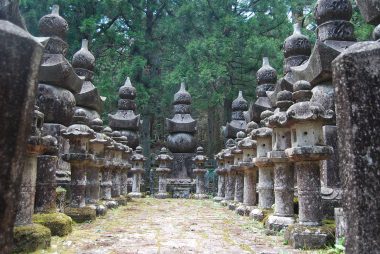
(Photo by Alena Eckelmann)
It’s not bedtime yet, as I have signed up for a night walk through Japan’s largest graveyard, the Okunoin. The walk will take us to the Kobo Daishi Gobyo, the mausoleum of Kobo Daishi. According to Koyasan legend, O-Daishi-sama, as believers affectionately refer to him, did not actually pass away, and has been sitting in Okunion in eternal meditation for over 1,200 years. You can see the monks bringing him food twice a day, at 6am and 10:30am.
Three bridges across small rivers mark the gateways from our mundane world into the sacred world of the saint. Our guide is a young monk from Ekoin Temple who instructs us in excellent English to bow at each bridge so as to greet Kobo Daishi.
Stone lanterns line the two-kilometer stone path to the mausoleum. They shed just enough light to make out countless gorinto (five-tiered stupas), which serve as gravestones. They consist of five different shapes and each tier is inscribed with five Sanskrit letters that represent the five elements: earth, water, fire, wind, and space.
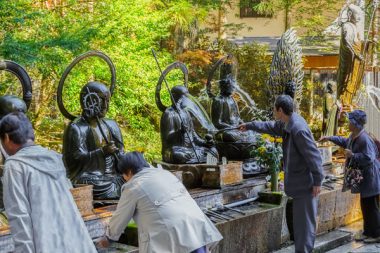
(Photo by Alena Eckelmann)
There are said to be over 200,000 graves, some centuries old and holding the remains of famous warlords, with other more recent ones possibly belonging to 20th-century Japanese businessmen. Regardless of religion, nationality, and status, anyone who believes in Kobo Daishi’s power can find a resting place here.
Before passing the third bridge—the last into the most inner sanctum—we walk by a row of Buddhist statues. The monk asks us to splash some water on them and pray for our ancestors. In front of the saint’s mausoleum stands the Torodo, or “Lantern Hall.” Here, over 10,000 lanterns donated by believers burn day and night. Walking to the Kobo Daishi Gobyo in the back, we stand with hands folded in gassho Buddhist prayer style. While the monk chants a prayer, we make a wish to Kobo Daishi.
No graveyard night walk is complete without some spooky folklore to go with it. A caution to those who visit: never drip water on the stone steps across the bridges. And make sure you’re able to see your reflection deep down in the well on the side of the path, or else your life might run short! If you dare test your strength by attempting to lift a karma stone, beware that failing to move it means you have accumulated too many sins in this life.
Back in the temple, a nice hot bath is a perfect way to end the day. The monks have laid out the futon. Shukubo rooms usually don’t have TVs, and it’s recommended that you leave your laptops and mobile phones switched off. Free of all modern distraction, I drift off to sleep, surrounded by nothing but pure serenity.
Chant and fire

(Photo by Alena Eckelmann)
The next day starts early. I wake up at 6am and get ready to attend otsutome, the morning ceremony where the monks chant Buddhist sutras. One of the monks greets guests at the entrance of the main temple hall. He places incense in the palms of our hands to purify us.
Candles are burning and incense wafting throughout the hall. More monks come in and find their seat near the main altar. A bell rings, and the monks start chanting the Hannya-rishu-kyo, the “Principle of Wisdom” sutra. Their deep voices seem to resonate in the air. I was sleepy before, but suddenly all of my senses are fully present.
On the other side of the room, one monk sits on a raised table with a cauldron in the middle, in which he kindles a fire. This is the goma fire ceremony that’s typically dedicated to Fudō Myōō, the “immovable wisdom” king. A statue of Myōō peers down on us from behind the altar, looking none too pleased. A raised sword in his right hand and a rope in his left, he looks ready to fight for each soul.
Later, a monk explains that in Buddhist teaching, human passions cause suffering, which keeps us from leading a happy and fulfilling life. However, this suffering can be ended if we make an effort to follow the path of proper conduct in mind, speech, and action. As a temporary measure to ensure happy days, we can enlist help from a higher realm.
The goma ki prayer sticks take our worldly wishes up to heaven with the smoke and rising flames. Good health, success in various endeavors like work and study, good family relations, or finding a love match … the Buddhist deities understand that we humans need a little help.
After the end of the prayer service, I feel spiritually cleansed, even though my stomach is rumbling with hunger. I’m thankful when I spot a group of monks rushing from the tem-ple to the kitchen at around 8am, promptly calling us for breakfast.
Follow your heart
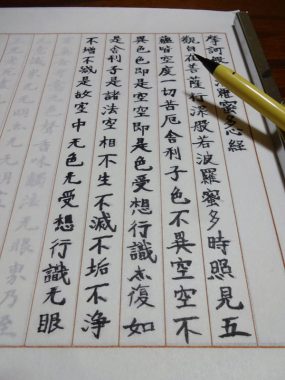
(Photo by Alena Eckelmann)
After satisfying my stomach, I am ready again for some spiritual intake. This morning I try shakyo, or sutra copying—another kind of meditation. I’m given the hannya shingyo (heart sutra), one of the most popular Buddhist scriptures. This sutra is said to be extremely powerful and Kobo Daishi is even said to have once used it in a healing ritual to ban an epidemic disease that had befallen Japan.
In front of me, a sheet of Japanese tracing paper lays atop a template from which I can copy. The two sheets are held in place with metal weights, and there’s a brush pen to the side. Before starting the practice, I wash my hands, rinse my mouth, and then put my hands together for a short prayer dedicated to Kobo Daishi. With concentration and focus, I slowly copy each of the 270 kanji of this sutra. This is a great exercise in mindfulness that surely helps me make a connection to my heart, although the deeper meaning of the sutra is beyond my grasp.
Exploring the Shingon universe
Around 10am, I am ready for a walk to the Danjo Garan, the ceremonial center of Koyasan. “Garan” literally means “a quiet place where Buddhist monks can practice.” When Kobo Daishi planned the monastery, he wanted a secluded place for mediation.
An imposing 50-meter-tall vermillion-red pagoda, the Konpon Daito (Great Pagoda), immediately catches my eye. It houses a three-dimensional mandala of the Shingon world. At its core is a seated statue of Dainichi Nyorai, the Cosmic Buddha, the main deity in this school of Buddhism. The pagoda is flanked by the statues of four other Buddhas, and each of the surround-ing 16 pillars features paintings of Bodhisattvas. On the corners of the building are paintings of the eight patriarchs of Shingon Buddhism, with the eighth depicting Kobo Daishi.
In the center of the Danjo Garan stands the Kondo (“golden hall”). Here, many of Koyasan’s ceremonies and rituals are held throughout the year. The Kechien Kanjo Buddhist initiations for laypeople are conducted here in May and October. In this ceremony, a karmic bond is estab-lished between the participant and a Buddha.
Blindfolded, each participant tosses a leaf onto a mandala that contains paintings of Bud-dhas, and depending on where the leaf falls, the respective Buddha will become your guide. Anyone who wishes to can attend.
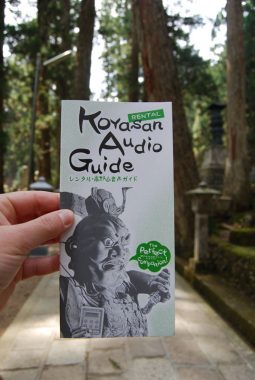
(Photo by Alena Eckelmann)
There are many other temples and shrines in the Danjo Garan complex. I take time to stroll around and listen to the detailed explanations of the Koya audio guide before head-ing to the Daishi Kyokai where laypeople can re-ceive the jukai (Buddhist precepts).
After signing up, I’m led into the dimly lit jukai-do (“precept hall”), where I sit down in front of a senior monk. I can barely make out his shape in the darkness. I repeat a sequence of sentences in Japanese, and step forward to receive a blessing from the monk. Within 30 minutes, I have gained my place in the Buddhist community.
Across the road is Kongobuji Temple, headquarters of Koya’s Shingon Buddhism and the administrative center for 4,000 Shingon temples across Japan. I come here for the lavish paintings on the sliding doors, which include a series depicting Kobo Dai-shi’s journey in China, as well as Japan’s largest rock garden. One-hundred-and-forty granite stones are set in a bed of white sand. The stones are said to depict a pair of dragons and the sand to symbolize clouds. This is a beautiful place for a moment of quiet contemplation.
A breeze of Buddhist teaching
The monks I encounter on Koyasan earnestly describe the history of the area and Kobo Daishi’s many achievements, while cheekily mixing in the occasional pearl of Buddhist wisdom. The story of the lotus that grows from murky water to become a clean white beautiful flower, for example, reminds us that we can be human beings with a pure heart, in spite of our surroundings or circumstances.
Shingon Buddhism teaches us that enlightenment can happen in this body and life, not many incarnations later. However, reaching the highest level of consciousness won’t happen without dedication and determination. While saying a prayer is fine, the deities expect us to make an effort first before chipping in.
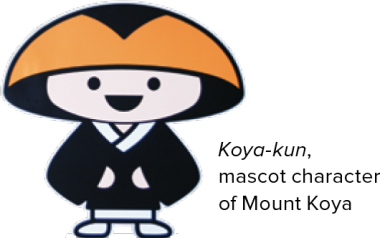 Access
Access
Japan Airlines services three flights a day to Nanki-Shirahama Airport from Tokyo’s Haneda Airport. www.jal.co.jp/en
Hiring a rental car is the best option for getting around Kumano and up to Koyasan. Car rental services are available at Nanki-Shirahama Airport and at Kii-Tanabe train station. Some cars are equipped with Eng-lish GPS.
Koyasan Checklist
• Ajikan: from Apr-Oct at Kongobuji Temple. Reservations essential.
• Otsutome: held every morning at 6am at Shukubo temples. Free for overnight guests to attend.
• Goma: conducted at certain temples only (please inquire when booking your stay); goma ki: ¥300-500.
• Kechien Kanjo: May 3-5 or Oct 1-3, open 8am-4pm. Book at the Daito reception desk. ¥3,000 per person each time.
• Koyasan Audio Guide: rental from Koya Town Tourist Information Center Central office, Ichinohashi office. ¥500 per day, until 10am the following morning; languages: English, French, Chinese, Korean, Japanese.
• Koya Town Tourist Information Center-Central office, Ichinohashi office, Nakanohashi office: for information, brochures, and maps in English, French, Italian, Chinese, Korean, and Thai. 9am-5pm (closed on Sat, Sun, & hols); www.koya.org.
• Jukai: at the Daishi Kyokai on the hour from 9am-4pm, except noon. 30 minutes ritual. ¥500.
• Night Walk: sign up at Ekoin Temple. Starts 7:15pm every night, depending on weather and monks’ availability. ¥1,500.
• Shakyo: at the Daishi Kyokai 8:30am-3pm, and at selected Shukubo (please inquire when booking your stay). ¥1,000 if the copied sutra is presented as offering to a deity, otherwise a paper fee of ¥100 is charged.
• Shukubo and Shojin Ryori: Koyasan Shukubo Assocation. 8:30am-5pm. www.shukubo.net.
Opening Times/Entrance Fees
• Danjo Garan: freely accessible at any time, ex-cept for Kondon Daito and Kondo. Free entrance.
• Daishi Kyokai: 8:30am-5pm.
• Kobo Daishi Gobyo: freely accessible at any time, except for the Torodo.
• Kondo: 8:30am-5pm. ¥200.
• Konpon Daito: 8:30am-5pm. ¥200.
• Kongobu-ji Temple: 8:30am-5pm. ¥500.
• Okuno-in: feely accessible at any time. Free entrance.
• Torodo: 6am-5:30pm. Free entrance.
